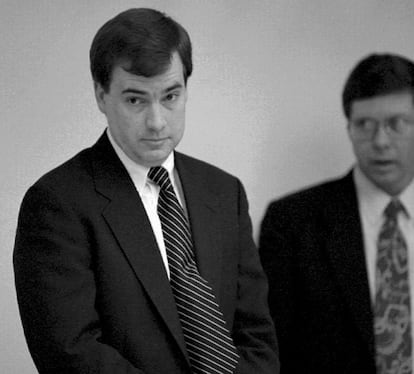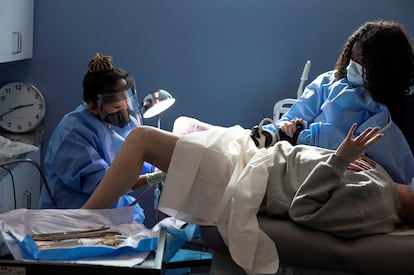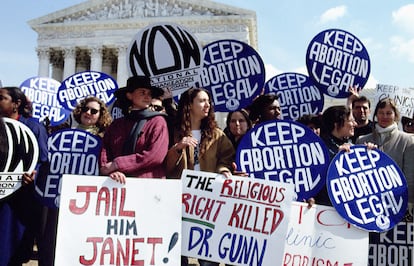David Gunn: 30 years since the assassination of a doctor sparked the US ‘abortion wars’
The death of the physician is commemorated every year on March 10 but providers still face threats and harassment despite the overturning of ‘Roe v. Wade’


At around 10am on March 10, 1993, a fanatic named Michael Frederick Griffin shot 47-year-old physician David Gunn in the back three times with a .38-caliber revolver as he arrived at the clinic where he worked in Pensacola, shouting repeatedly: “You’re not killing any more babies!” Griffin then turned himself in to the police. Gunn, a father of two, was the only practitioner performing legal abortions in northeast Florida. He covered an area of around 1,000 miles, including parts of Georgia and Alabama. On the morning of March 10, he was greeted - as he was every morning - by yelling activists who had been waiting for him for around an hour. He knew that his job entailed risks, so he always carried three guns in his car. Months earlier, his image had been superimposed onto a mock-up of a Western outlaw “Wanted” poster at a rally in Montgomery, Alabama, organized by Operation Rescue, one of the first and most radical anti-abortion organizations in the United States. Founded in 1986, its slogan was: “If you believe abortion is murder, act like it’s murder.”
Griffin, a 31-year-old Christian fundamentalist who had seen a photograph of Gunn in the garage of his mentor - a white supremacist named Paul Burt whom he would later accuse at trial of brainwashing him - entered the annals of US terrorism by committing the first documented murder of a reproductive health care provider. The assassination of Gunn sparked the so-called “abortion wars,” which had already involved skirmishes including kidnappings, assaults, and attacks on clinics. Griffin was sentenced to life and, if a hearing on his case scheduled for next year elects not to review his sentence, he will not be eligible for parole until 2043.

In remembrance of Gunn, the United States has marked National Abortion Provider Recognition Day every March 10 since 1996. This year, though, the day hold even more significance: it is the first commemoration since the Supreme Court’s decision last June to overturn the 1973 precedent set by Roe v. Wade, which guaranteed federal protection for a woman’s right to seek an abortion. The ruling returned the power to legislate on abortion to the states: at least 18 have decided to ban or severely restrict it and in a dozen states, including Texas and Louisiana, new laws threaten prison sentences of up to 15 years for doctors or nurses who perform abortions outside the permitted legal parameters. This has led to many medical professionals having to seek legal advice and to weigh decisions on the most uncertain cases between the Hippocratic oath and the criminal code.
Shelly Tien, 41, is one of those medical professionals whose work is being recognized this March 10. In a telephone conversation with EL PAÍS, she said she plans to mark the day by “working.” She also considers herself fortunate, she says, “never to have been physically attacked” despite the numerous threats she receives. She also rules out ceasing to practice, out of “respect for science, love for society and pure responsibility.” Tien, who is also a specialist in high-risk pregnancies, splits her time between a clinic in Jacksonville, Florida, and others in Arizona and Kansas. She used to travel to provide her services in Alabama and Oklahoma, until the law prevented her from doing so.
The Jacksonville clinic is one of 18 in Florida operated by Planned Parenthood, the largest provider of abortion services in the United States and which manages about half of all abortion centers in the country. The 18 clinics in Florida are currently awaiting a decision by the state legislature over whether to lower the legal timeframe for performing abortions – both surgical and chemical - to six weeks. It is one of the multiple battlefronts of the ultra-conservative war being waged by Governor Ron DeSantis, who is expected to run for the White House in 2024.

A near-total ban on abortion
If the law is approved, it would amount to a near-total ban: “Most women don’t even know they are pregnant by then,” says Tien. “Such a restriction will have a huge impact on those who are pregnant and don’t want to be, but also on those who want to be but develop complications. It would force many to travel to other parts of the country.” It would also force Tien to do the same thing, in order to continue practicing.
In Pensacola, where Gunn was killed, there are no longer any reproductive health centers after the last remaining one was closed in 2022 by administrative order after complaints were lodged of complications following procedures performed on two women. Julie Gallagher, an attorney representing the clinic, said in a written statement that “these are two, and only two, cases out of more than 100,000 patients seen.”
The clinic had been open, under different names, for 45 years. It too entered the infamous history of the abortion wars when in 1994 physician John Britton, who was Gunn’s replacement, was shot dead by anti-abortion extremist Paul Jennings Hill. Britton’s bodyguard James Barrett Jr was also killed and his wife, June, was wounded.
The 1990s were the peak years of anti-abortion violence in the United States. “That escalation was due to the frustration of the most radical elements of the movement, who became convinced that the legal route was not going to work for them,” says legal historian Mary Ziegler, author of several books on the subject. The most recent is entitled Roe: The History of a National Obsession (2023). Ziegler points to the setback anti-abortionists received when the Supreme Court upheld the Roe precedent by 5-4 in the Planned Parenthood v. Casey case of 1992. “Seeing themselves defeated, they resorted to violence.”

During the 1990s fanatics killed another doctor, Barnett Slepian, in 1998, as well as two receptionists and a security guard in two separate attacks. In 2009, George Tiller, who had survived an attempt on his life 26 years earlier, became the fourth physician to be killed. The National Abortion Federation (NAF) has been compiling statistics on anti-abortionist violence since 1977. In a 2017 statement on the decision to deny Griffin parole, the NAF said that in the previous 40 years there had been “11 murders, 26 attempted murders, 42 bombings, 186 arsons, and thousands of incidents of criminal activities directed at abortion providers.”
“Gunn’s assassination was important because it served to humanize specialists, who had been demonized in previous decades by those who wanted to cast them as killers who did not practice medicine,” Ziegler says. “In the American psyche, the provider went from being an abstract entity to being identified with Dr. Gunn, a flesh-and-blood person. It also served to bring to light links between the most extreme faction of the anti-abortion movement with white supremacism and the far right.”
“For women’s right-to-decide advocates, Gunn’s death signaled a new frontier,” says Florida State University professor Deanna Rohlinger, author of Abortion Politics, Mass Media, and Social Movements in America (2014), via email. “On the other side of that frontier, providers were literally risking their lives. For anti-abortion extremists, Griffin became a symbol to an aspiration: to end the ‘murder’ of the unborn by any means, including violence. And while the mainstream anti-abortion movement rejected such violence, it remained silent on other tactics related to shutting down clinics because direct action attracted supporters to the cause.”
Over time such “tactics” became more sophisticated after a law was enacted in the wake of Gunn’s death that made the use of force, threats, and physical obstruction at the entrances of clinics a federal crime. Each state designed its own rules but in many, abortion centers chose locations in sparsely populated areas and adopted their own tactic of building huge parking lots to keep protesters off the property, and away from patients. “Attacks on our clinics have increased in recent years,” says Clara Trullenque, a spokesperson for Planned Parenthood in Miami. She says two of the organization’s centers were vandalized last year. “At the one in Jacksonville, for example, there are fences around the building for protection,” she adds.
Despite the ground gained by the anti-abortion movement, whose greatest victory was last year’s Supreme Court decision, there has been little let-up in the harassment of medical professionals. “On the contrary,” says Ziegler, “these protests have shifted from the most conservative places, where abortion has already been banned, to others where it is still permitted.”
Neither are anti-abortionists letting up in the courts: a federal judge in Texas is due to rule on the legality of mifepristone, which in combination with another drug is used for the termination of pregnancy. If the lawsuit is successful, mifepristone will no longer be available nationwide, including in states where abortion is legal.
Sign up for our weekly newsletter to get more English-language news coverage from EL PAÍS USA Edition
Tu suscripción se está usando en otro dispositivo
¿Quieres añadir otro usuario a tu suscripción?
Si continúas leyendo en este dispositivo, no se podrá leer en el otro.
FlechaTu suscripción se está usando en otro dispositivo y solo puedes acceder a EL PAÍS desde un dispositivo a la vez.
Si quieres compartir tu cuenta, cambia tu suscripción a la modalidad Premium, así podrás añadir otro usuario. Cada uno accederá con su propia cuenta de email, lo que os permitirá personalizar vuestra experiencia en EL PAÍS.
¿Tienes una suscripción de empresa? Accede aquí para contratar más cuentas.
En el caso de no saber quién está usando tu cuenta, te recomendamos cambiar tu contraseña aquí.
Si decides continuar compartiendo tu cuenta, este mensaje se mostrará en tu dispositivo y en el de la otra persona que está usando tu cuenta de forma indefinida, afectando a tu experiencia de lectura. Puedes consultar aquí los términos y condiciones de la suscripción digital.
More information
Archived In
Últimas noticias
Most viewed
- David King, chemist: ‘There are scientists studying how to cool the planet; nobody should stop these experiments from happening’
- Reinhard Genzel, Nobel laureate in physics: ‘One-minute videos will never give you the truth’
- Mexico completes its trade shift with the entry into force of tariffs on China and countries without trade agreements
- Oona Chaplin: ‘I told James Cameron that I was living in a treehouse and starting a permaculture project with a friend’
- Sinaloa Cartel war is taking its toll on Los Chapitos










































